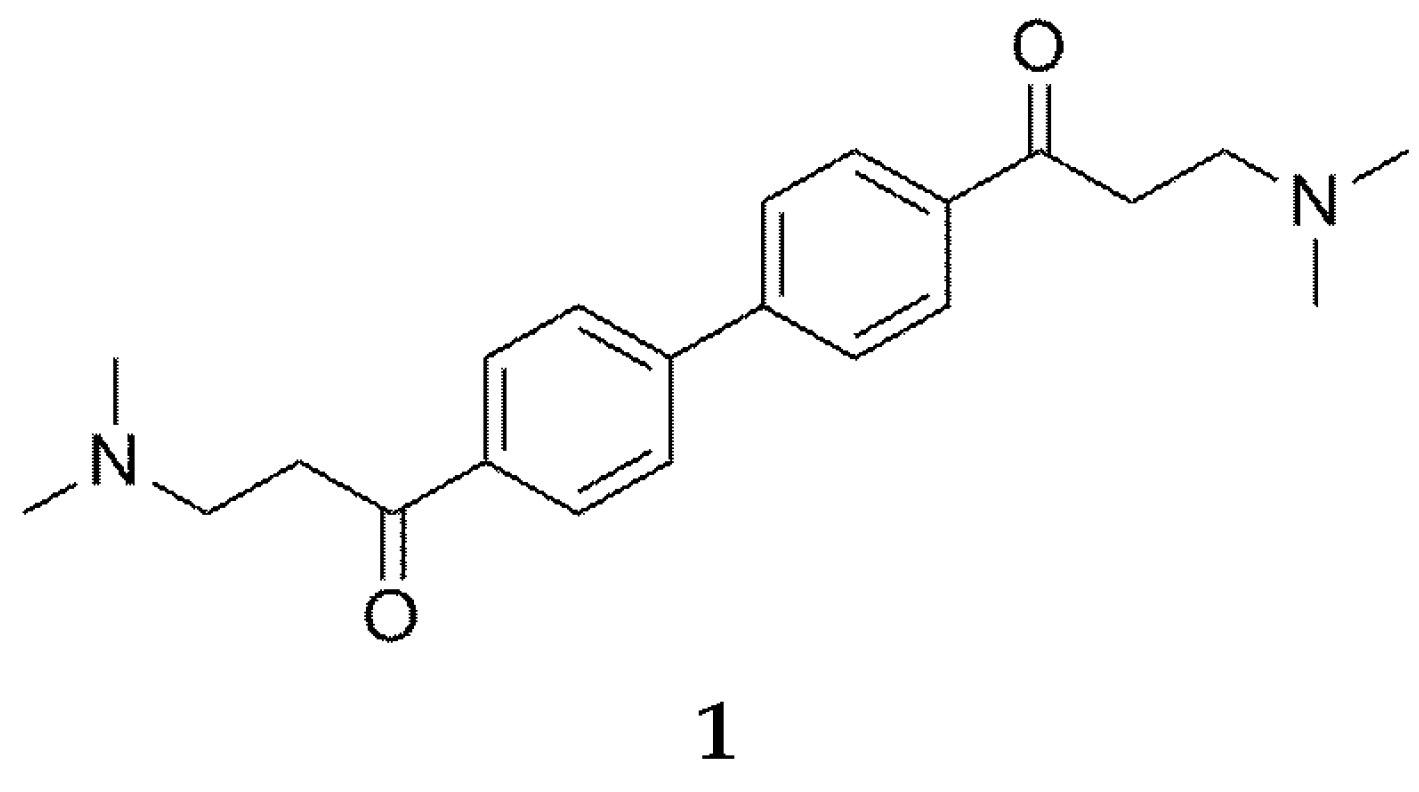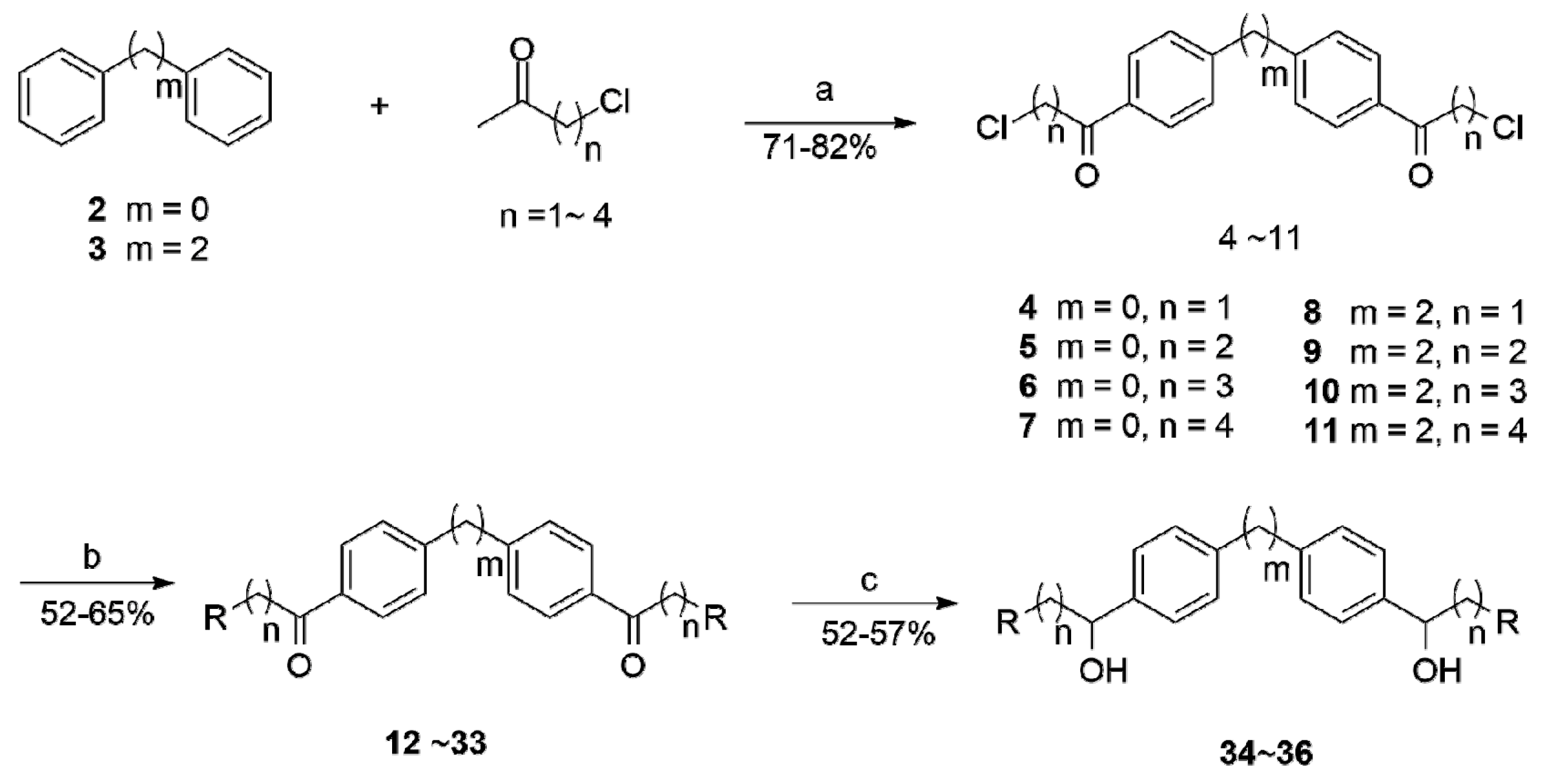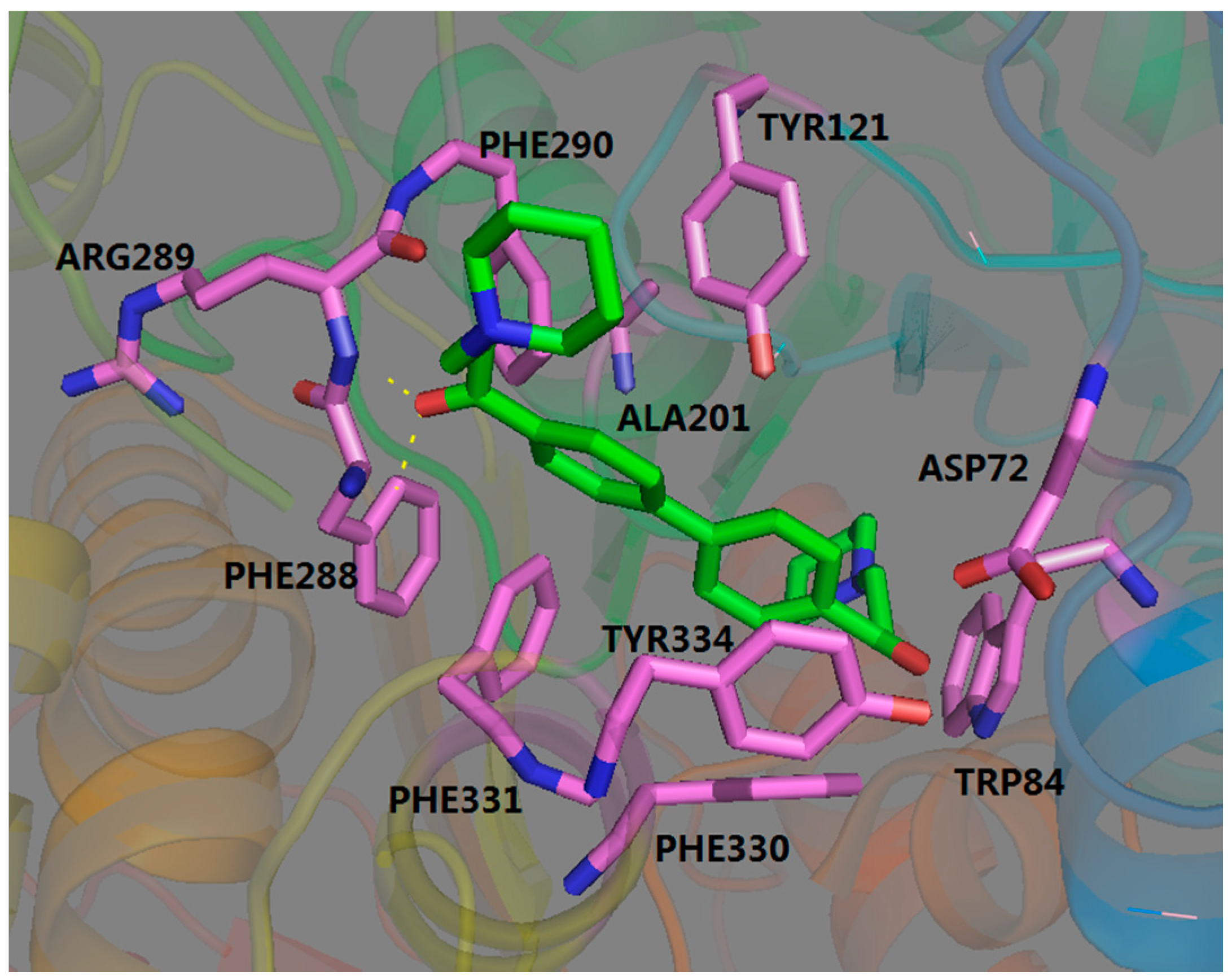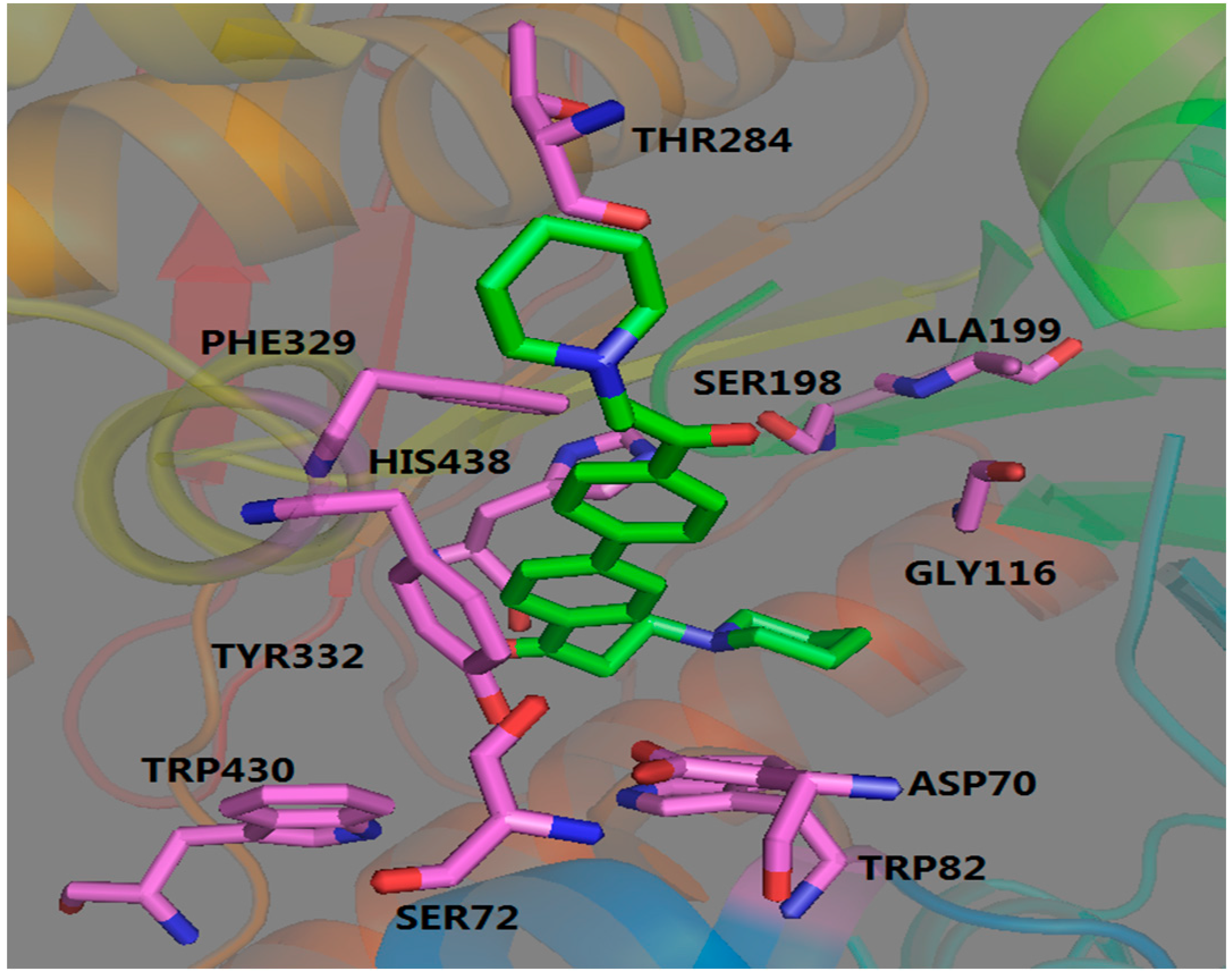Design, Synthesis, and Biological Evaluation of a New Series of Biphenyl/Bibenzyl Derivatives Functioning as Dual Inhibitors of Acetylcholinesterase and Butyrylcholinesterase
Abstract
:1. Introduction
2. Results and Discussion
2.1. Chemistry
2.2. Biological Evaluation and SAR Analysis
2.3. Molecular Docking
3. Materials and Methods
3.1. Chemistry
3.1.1. General Method for Synthesis of Friedel-Crafts Acylation Intermediates (4–11)
3.1.2. General Method for Synthesis of the Target Compounds (12–33)
3.1.3. General Method for Synthesis of Target Compounds (34–36)
3.2. Biological Evaluation
3.3. Molecular Docking
4. Conclusions
Acknowledgments
Author Contributions
Conflicts of Interest
References
- Goedert, M.; Spillantini, M.G. A century of Alzheimer’s disease. Science 2006, 314, 777–781. [Google Scholar] [CrossRef] [PubMed]
- Shankar, G.M.; Li, S.; Mehta, T.H.; Garcia-Munoz, A.; Shepardson, N.E.; Smith, I.; Brett, F.M.; Farrell, M.A.; Rowan, M.J.; Lemere, C.A. Amyloid-β protein dimers isolated directly from Alzheimer’s brains impair synaptic plasticity and memory. Nat. Med. 2008, 14, 837–842. [Google Scholar] [CrossRef] [PubMed]
- Grundke-Iqbal, I.; Iqbal, K.; Tung, Y.C.; Quinlan, M.; Wisniewski, H.M.; Binder, L.I. Abnormal phosphorylation of the microtubule-associated protein tauin Alzheimer cytoskeletal pathology. Proc. Natl. Acad. Sci. USA 1986, 83, 4913–4917. [Google Scholar] [CrossRef] [PubMed]
- Gella, A.; Durany, N. Oxidative stress in Alzheimer disease. Cell Adhes. Migr. 2009, 3, 88–93. [Google Scholar] [CrossRef]
- Rosini, M.; Simoni, E.; Milelli, A.; Minarini, A.; Melchiorre, C. Oxidative Stress in Alzheimer’s Disease: Are We Connecting the Dots? Miniperspective. J. Med. Chem. 2014, 57, 2821–2831. [Google Scholar] [CrossRef] [PubMed]
- Schelterns, P.; Feldman, H. Treatment of Alzheimer’s disease; current status and new perspectives. Lancet Neurol. 2003, 2, 539–547. [Google Scholar]
- Smith, D.A. Treatment of Alzheimer’s disease in the long-term-care setting. Am. J. Health Syst. Pharm. 2009, 66, 899–907. [Google Scholar] [CrossRef] [PubMed]
- Pepeu, G.; Giovannini, M.G. Cholinesterase inhibitors and beyond. Curr. Alzheimer Res. 2009, 6, 86–96. [Google Scholar] [CrossRef] [PubMed]
- Grossberg, G.T.; Pejović, V.; Miller, M.L.; Graham, S.M. Memantine therapy of behavioral symptoms in community-dwelling patients with moderate to severe Alzheimer’s disease. Dement. Geriat. Cogn. Disord. 2009, 27, 164–172. [Google Scholar] [CrossRef] [PubMed]
- Mesulam, M.M.; Guillozet, A.; Shaw, P.; Levey, A.; Duysen, E.G.; Lockridge, O. Acetylcholinesterase knockouts establish central cholinergic pathways and can use butyrylcholinesterase to hydrolyze acetylcholine. Neuroscience 2002, 110, 627–639. [Google Scholar] [CrossRef]
- Perry, E.K.; Perry, R.H.; Blessed, G.; Tomlinson, B.E. Changes in brain cholinesterases in senile dementia of Alzheimer type. Neuropathol. Appl. Neurobiol. 1978, 4, 273–277. [Google Scholar] [CrossRef] [PubMed]
- Giacobini, E.; Spiegel, R.; Enz, A.; Veroff, A.E.; Cutler, N.R. Inhibition of acetyl-and butyryl-cholinesterase in the cerebrospinal fluid of patients with Alzheimer’s disease by rivastigmine: Correlation with cognitive benefit. J. Neurol. Transm. 2002, 109, 1053–1065. [Google Scholar] [CrossRef] [PubMed]
- Greig, N.H.; Utsuki, T.; Ingram, D.K.; Wang, Y.; Pepeu, G.; Scali, C.; Yu, Q.S.; Mamczarz, J.; Holloway, H.W.; Giordano, T. Selective butyrylcholinesterase inhibition elevates brain acetylcholine, augments learning and lowers Alzheimer β-amyloid peptide in rodent. Proc. Natl. Acad. Sci. USA 2005, 102, 17213–17218. [Google Scholar] [CrossRef] [PubMed]
- Horton, D.A.; Bourne, G.T.; Smythe, M.L. The combinatorial synthesis of bicyclic privileged structures or privileged substructures. Chem. Rev. 2003, 103, 893–930. [Google Scholar] [CrossRef] [PubMed]
- Hajduk, P.J.; Bures, M.; Praestgaard, J.; Fesik, S.W. Privileged molecules for protein binding identified from NMR-based screening. J. Med. Chem. 2000, 43, 3443–3447. [Google Scholar] [CrossRef] [PubMed]
- Fang, J.; Yang, R.; Gao, L.; Zhou, D.; Yang, S.; Liu, A.L.; Du, G.H. Predictions of BuChE Inhibitors Using Support Vector Machine and Naive Bayesian Classification Techniques in Drug Discovery. J. Chem. Inf. Model. 2013, 53, 3009–3020. [Google Scholar] [CrossRef] [PubMed]
- Ellman, G.L.; Courtney, K.D.; Andres, V., Jr.; Feather-Stone, R.M. A new and rapid colorimetric determination of acetylcholinesterase activity. Biochem. Pharmacol. 1961, 7, 88–95. [Google Scholar] [CrossRef]
- Sample Availability: Samples of the compounds 12–33 are available from the authors.




| Compounds a | m | n | R | IC50 µM ± SEM | |
|---|---|---|---|---|---|
| AChE b ± SEM | BuChE c ± SEM | ||||
| 12 | 0 | 1 |  | d | 91.68 ± 15.68 |
| 13 | 0 | 1 |  | d | 71.68 ± 3.01 |
| 14 | 0 | 1 |  | d | 1.44 ± 0.23 |
| 15 | 0 | 2 |  | 1.18 ± 0.29 | 0.74 ± 0.09 |
| 16 | 0 | 2 |  | 0.88 ± 0.17 | 2.83 ± 0.50 |
| 17 | 0 | 2 |  | 0.71 ± 0.06 | 2.39 ± 0.75 |
| 18 | 0 | 2 |  | 0.33 ± 0.06 | 1.16 ± 0.09 |
| 19 | 0 | 2 |  | 0.096 ± 0.006 | 1.25 ± 0.15 |
| 20 | 0 | 2 |  | 0.97 ± 0.08 | 0.72 ± 0.10 |
| 21 | 0 | 2 |  | 1.43 ± 0.33 | 1.94 ± 0.07 |
| 22 | 0 | 2 |  | 1.61 ± 0.38 | 13.77 ± 0.81 |
| 23 | 0 | 3 |  | 1.32 ± 0.43 | 5.9 ± 0.40 |
| 24 | 0 | 4 |  | 0.82 ± 0.16 | 2.65 ± 0.11 |
| 25 | 2 | 1 |  | 62.27 ± 14.46 | 9.11 ± 2.55 |
| 26 | 2 | 1 |  | 74.54 ± 8.50 | 20.72 ± 5.44 |
| 27 | 2 | 1 |  | 74.13 ± 11.53 | 66.51 ± 17.04 |
| 28 | 2 | 1 |  | d | 6.30 ± 1.60 |
| 29 | 2 | 2 |  | 2.62 ± 0.63 | 1.21 ± 0.22 |
| 30 | 2 | 2 |  | 0.50 ± 0.06 | 3.14 ± 0.24 |
| 31 | 2 | 2 |  | 3.53 ± 0.79 | 6.38 ± 1.26 |
| 32 | 2 | 3 |  | 3.67 ± 0.92 | 19.18 ± 4.78 |
| 33 | 2 | 4 |  | 0.19 ± 0.08 | 1.64 ± 0.27 |
| 34 | 0 | 2 |  | 31.74 ± 10.24 | 13.78 ± 1.59 |
| 35 | 0 | 2 |  | d | d |
| 36 | 2 | 2 |  | 74.93 ± 35.56 | 25.94 ± 6.81 |
| Donepezil | 0.044 | ||||
| ISO-OMPA | 0.72 | ||||
© 2017 by the authors. Licensee MDPI, Basel, Switzerland. This article is an open access article distributed under the terms and conditions of the Creative Commons Attribution (CC BY) license ( http://creativecommons.org/licenses/by/4.0/).
Share and Cite
Wang, D.-m.; Feng, B.; Fu, H.; Liu, A.-l.; Wang, L.; Du, G.-h.; Wu, S. Design, Synthesis, and Biological Evaluation of a New Series of Biphenyl/Bibenzyl Derivatives Functioning as Dual Inhibitors of Acetylcholinesterase and Butyrylcholinesterase. Molecules 2017, 22, 172. https://doi.org/10.3390/molecules22010172
Wang D-m, Feng B, Fu H, Liu A-l, Wang L, Du G-h, Wu S. Design, Synthesis, and Biological Evaluation of a New Series of Biphenyl/Bibenzyl Derivatives Functioning as Dual Inhibitors of Acetylcholinesterase and Butyrylcholinesterase. Molecules. 2017; 22(1):172. https://doi.org/10.3390/molecules22010172
Chicago/Turabian StyleWang, Dong-mei, Bo Feng, Hui Fu, Ai-lin Liu, Lin Wang, Guan-hua Du, and Song Wu. 2017. "Design, Synthesis, and Biological Evaluation of a New Series of Biphenyl/Bibenzyl Derivatives Functioning as Dual Inhibitors of Acetylcholinesterase and Butyrylcholinesterase" Molecules 22, no. 1: 172. https://doi.org/10.3390/molecules22010172







